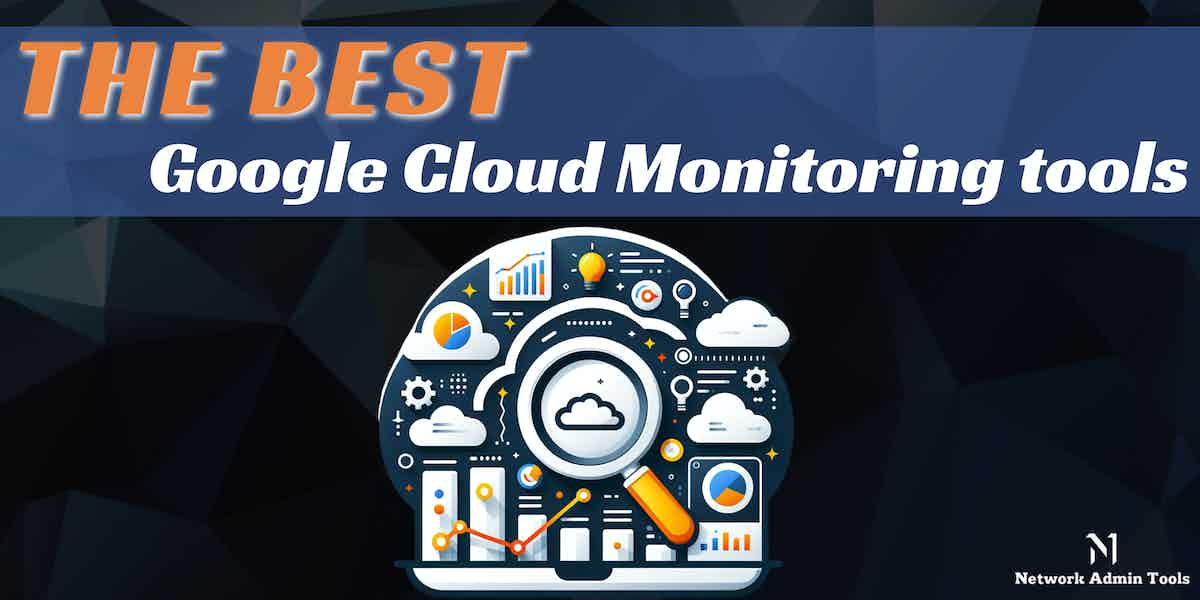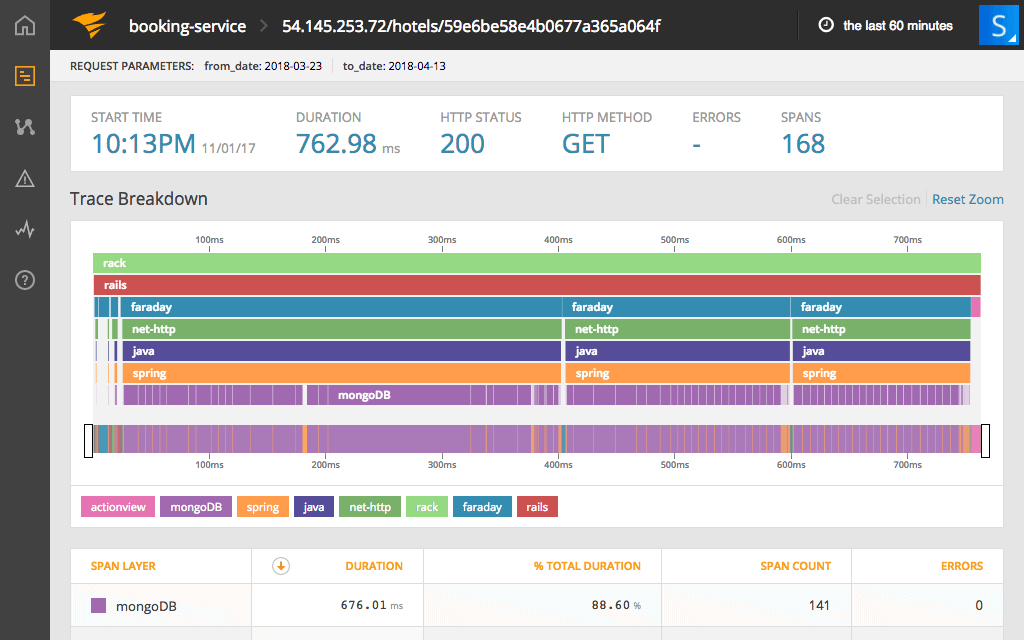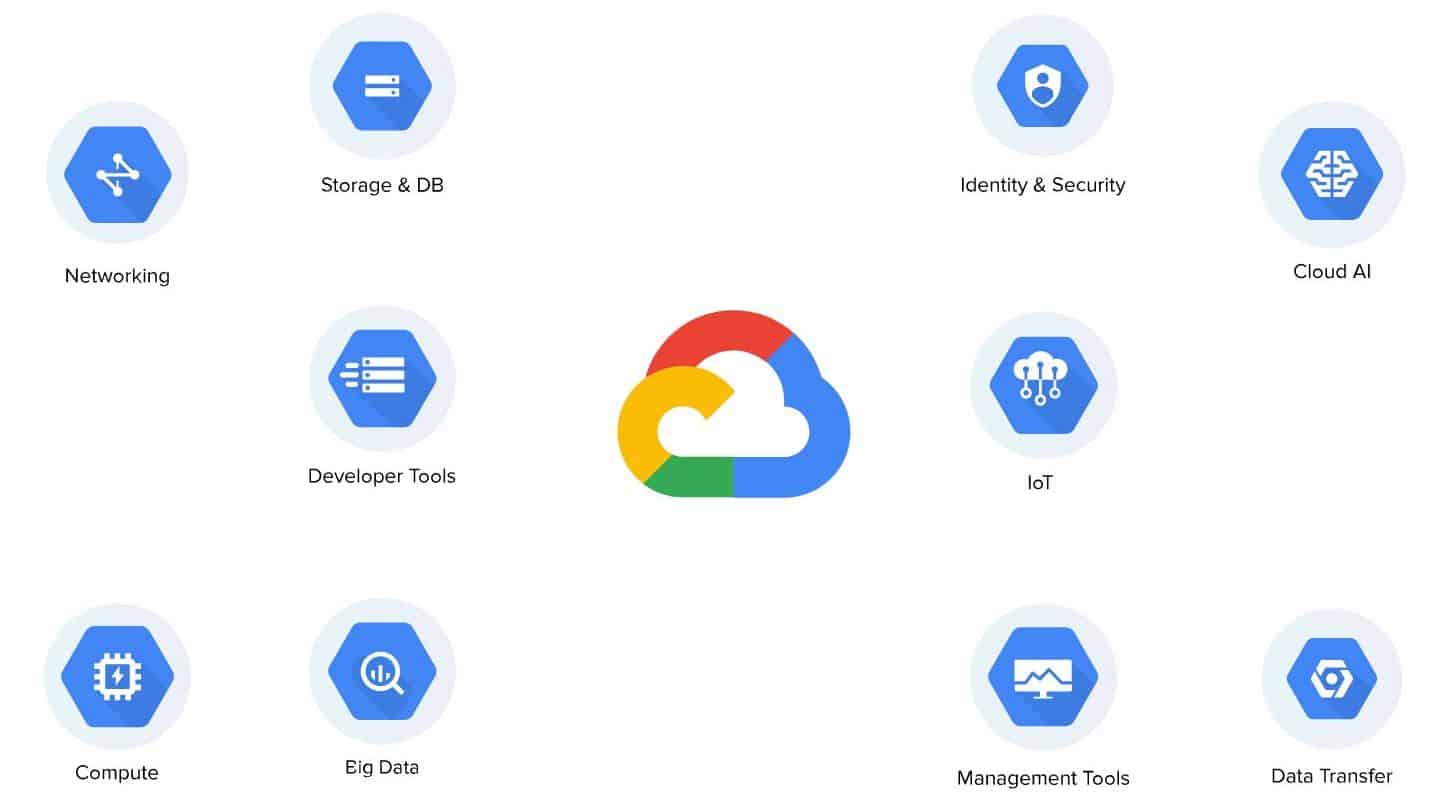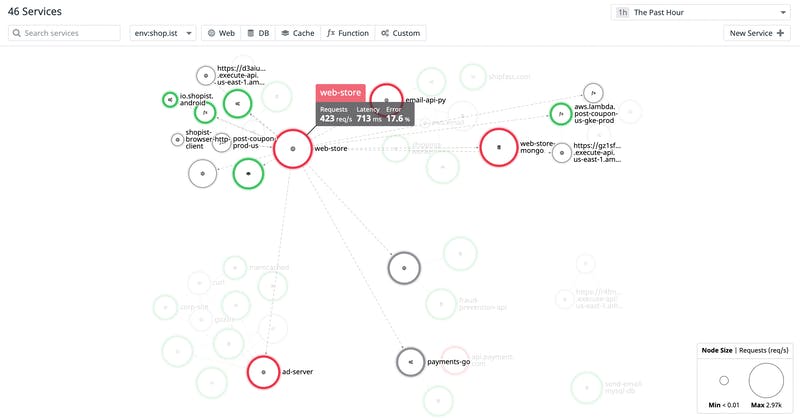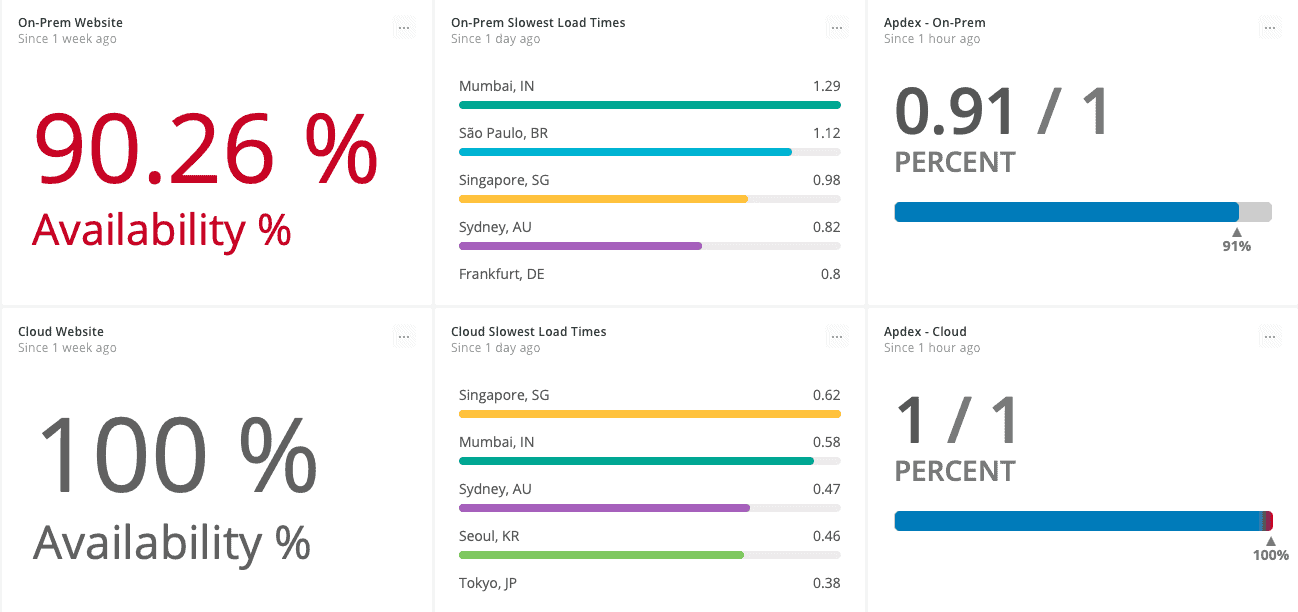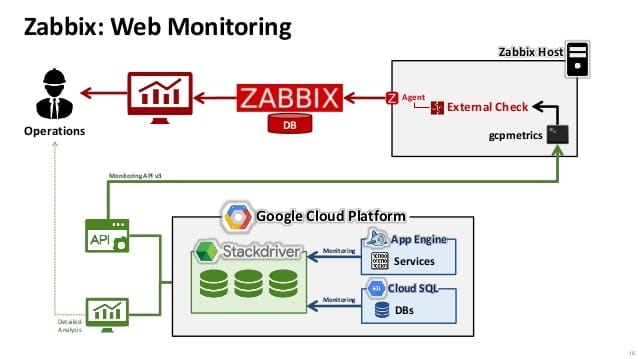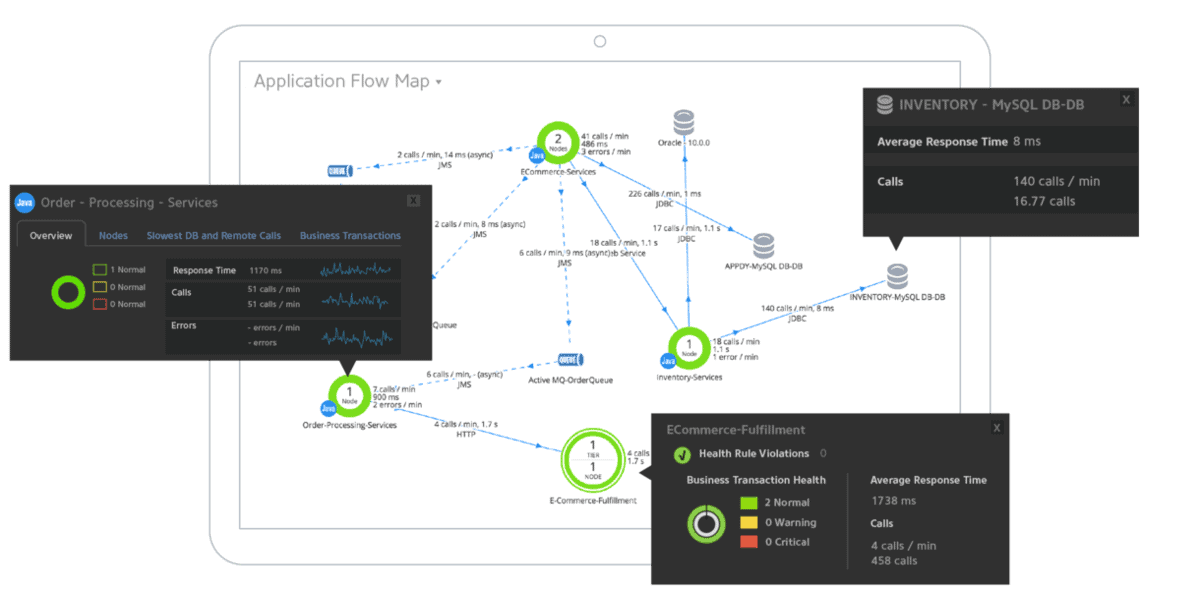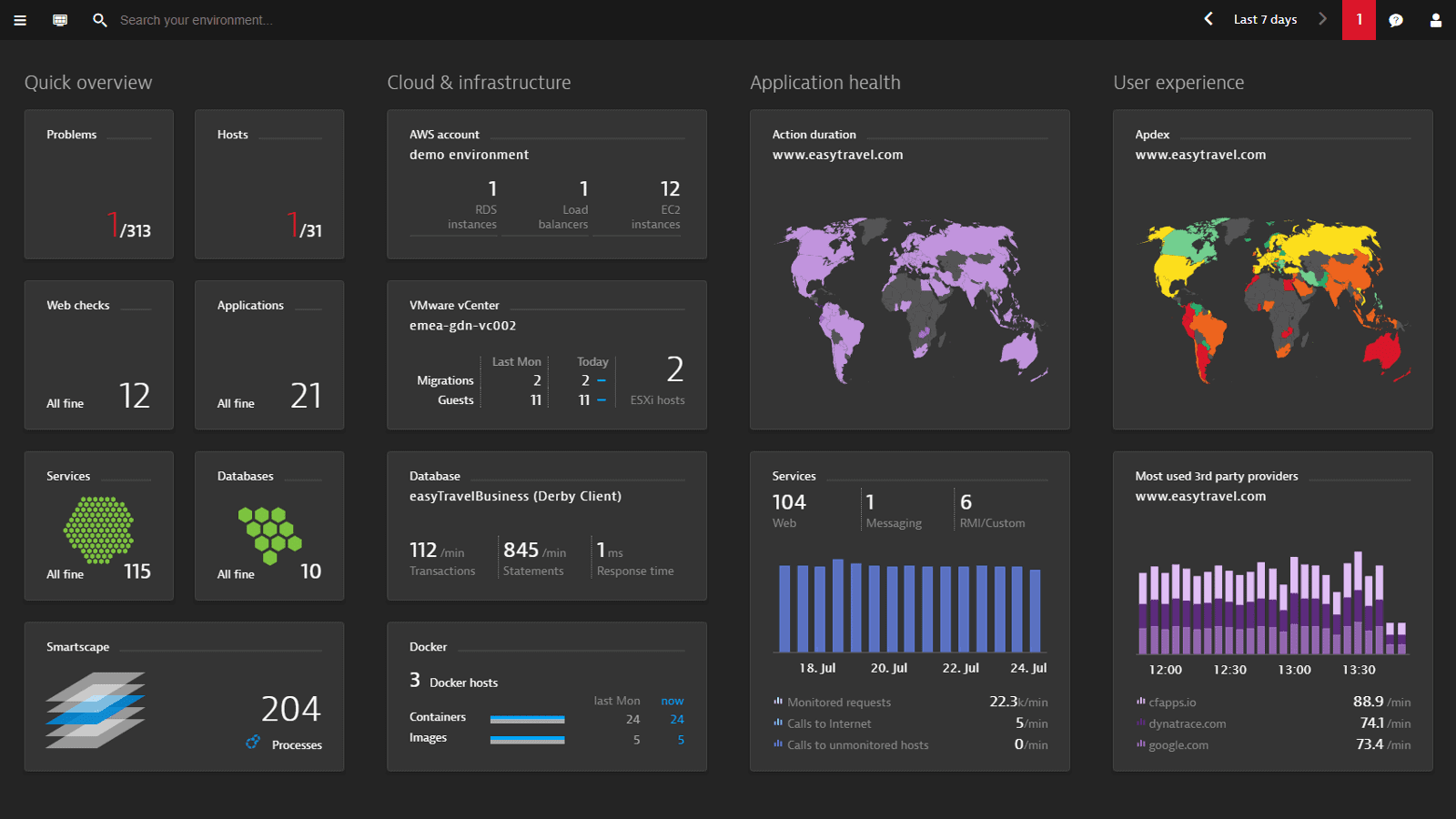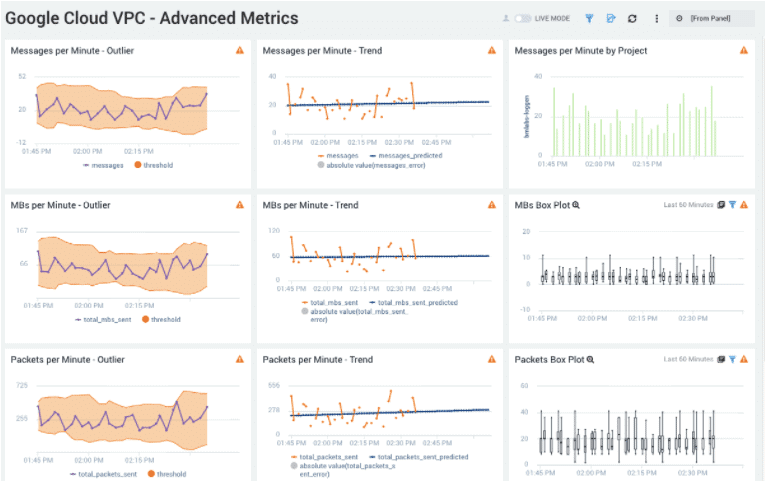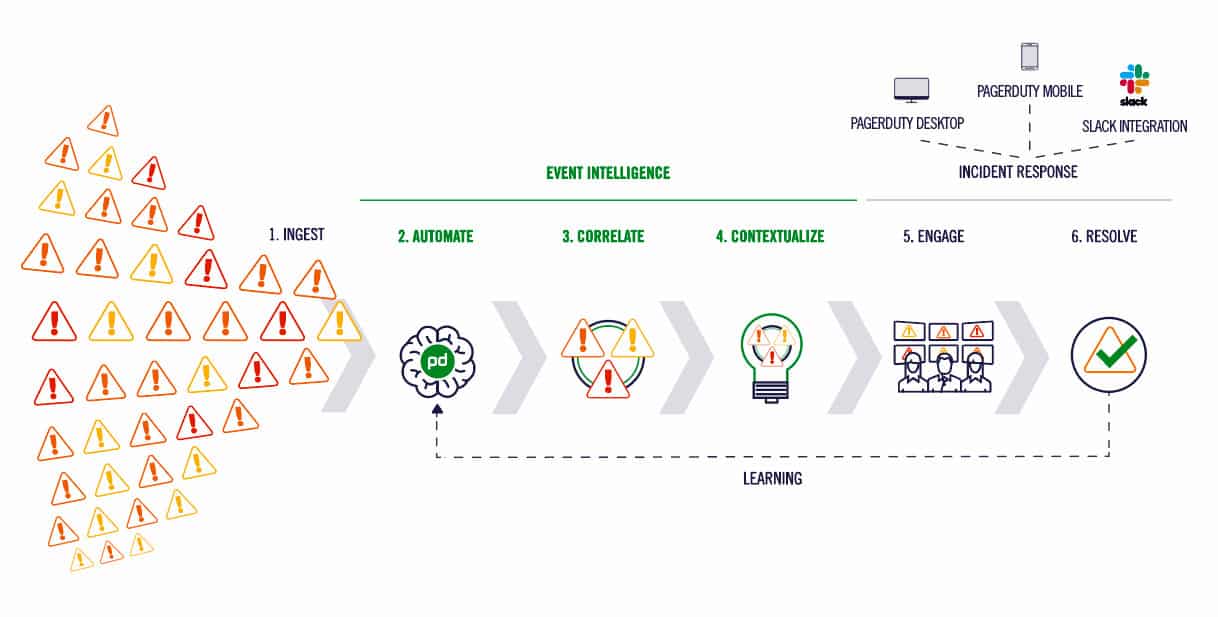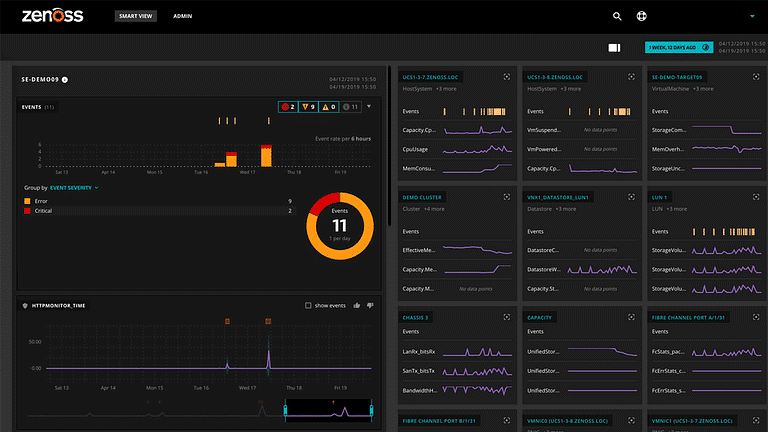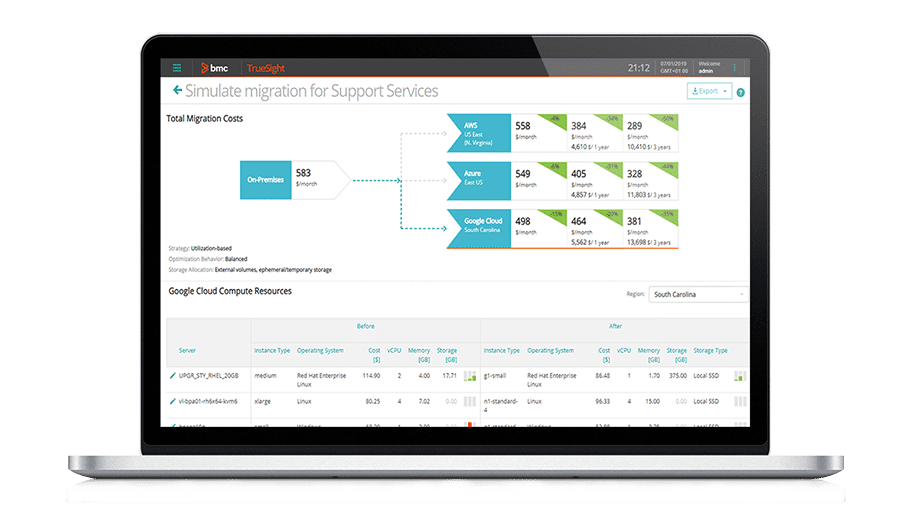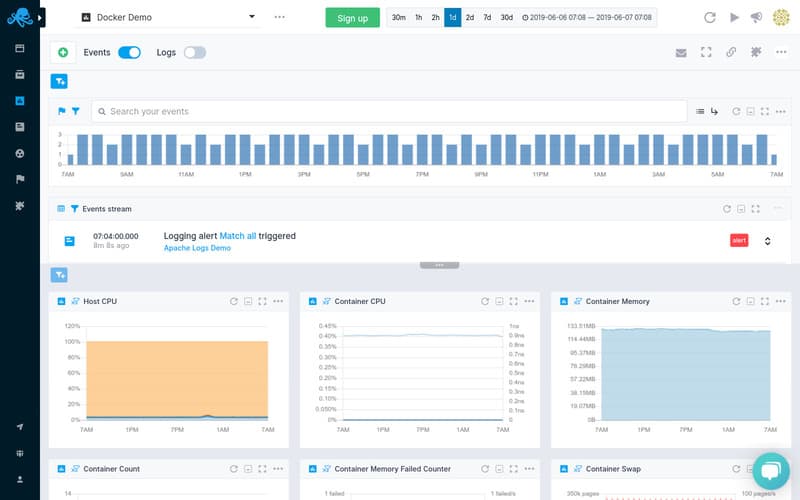Google Cloud is a suite of cloud computing services from the renowned company and all of it runs on Google’s own scalable, reliable, and robust infrastructure. It is estimated that more than eight million websites and applications are powered by Google Cloud and it has seen rapid growth in the last few years.
Like other cloud platforms, Google Cloud needs to be monitored too, as it hosts many critical applications for your company. So, if you’re planning to move to Google Cloud anytime soon or if you already have a presence on Google Cloud, there are a number of monitoring tools that can come in handy for you.
Here is our list of the Best Google Cloud Monitoring Tools:
- AppOptics Infrastructure Monitoring – FREE TRIAL Α powerful SaaS tool for monitoring your application hosted on Google Cloud. It comes with a host of integrations and powerful features to give complete visibility into the health and performance of your cloud infrastructure. Get a 30-day-free trial.
- ManageEngine Applications Manager – FREE TRIAL This package is able to perform activity and performance monitoring for GCPO as well as AWS, Azure, Oracle Cloud, and on-premises servers. This platform monitoring is performed alongside applications monitoring Available for Windows Server, Linux, AWS, and Azure. Start a 30-day free trial.
- Site24x7 – FREE TRIAL Monitors your Google Cloud Platform in real-time and provides actionable insights for quick detection and fixing of problems in your cloud infrastructure. Its AI-powered engine helps you to resolve issues before end-users are impacted. Start a 30-day free trial.
- Datadog A Google Cloud Platform integration that provides full observability into dynamic environments to manage their complexity and efficiently diagnose issues before impacting the business. Its integrations ensure that you have a complete view of every GCP service.
- NewRelic A comprehensive tool for providing visibility across the infrastructure, applications, and the overall digital experience of end-customers on the Google Cloud Platform.
- Zabbix A monitoring tool that helps you to stay on top of the infrastructure, services, networks, services, applications, resources, and more. This open-source monitoring tool works well for the Google Cloud Platform as well.
- AppDynamics A part of Cisco, monitors business and application performance to give you unified insights for better decision making. With a host of features such as real-time monitoring, advanced reporting, and more, this is a handy tool to stay on top of the applications and infrastructure on Google Cloud.
- DynaTrace Google Cloud monitoring capabilities are advanced and comprehensive, tap into the power of AI to give all the information you need.
- SumoLogic A tool that collates data across different environments and sources to give you a comprehensive idea of the health and availability of your infrastructure at any time.
- PagerDuty Integrates with the Google Stackdriver to collate information about your Google Cloud’s performance and take the necessary actions for optimization.
- Zenoss Integrates with the Google Cloud Platform to monitor all-cloud or hybrid cloud environments and to provide detailed insights for an actionable and efficient decision-making process.
- BMC TrueSight Pulse A SaaS-based infrastructure monitoring service that provides granular insight into your metrics for quick detection and resolution of issues.
- Sematext Cloud A cloud-based SaaS tool for monitoring your cloud environments. It collects logs and metrics to give you a first-hand view of your infrastructure’s health and performance.
Let’s now do a deep dive into the features and pricing of each of these tools. We will also share a download link where you can download or sign up for a free trial as applicable.
Our methodology for selecting Google Cloud Monitoring tool
We’ve broken down our analysis for you based on these key criteria:
- Integration capabilities with Google Cloud services
- Real-time monitoring and alerting features
- Ability to handle log management and full-text search
- User-friendliness and clarity in reporting and data visualization
- Support for custom application and infrastructure metric tracking
The Best Google Cloud Monitoring Tools
1. AppOptics Infrastructure Monitoring – FREE TRIAL
AppOptics Infrastructure is a powerful SaaS tool for monitoring your applications hosted on Google Cloud. It comes with a host of integrations and powerful features to give complete visibility into the health and performance of your cloud infrastructure.
Key Features:
- Traces and visualizes application bottlenecks
- Monitor’s website availability and responsiveness
- Aggregates and summarizes log data
- Creates visually appealing graphs and reports
- Sends real-time alerts
- Provides insights into custom application and infrastructure metrics
- Handles log management efficiently and allows full-text search
- Analyzes data streams
Why do we recommend it?
AppOptics Infrastructure offers a comprehensive suite of monitoring capabilities specifically designed for applications hosted on Google Cloud. Its ability to trace application bottlenecks, manage logs efficiently, and provide real-time alerts sets it apart as a robust monitoring solution.
Who is it recommended for?
This tool is recommended for businesses that rely heavily on Google Cloud for hosting their applications. Whether you are a small business or a large enterprise, AppOptics is well-suited for anyone looking to gain full visibility into cloud infrastructure performance and health.
Pros:
- Traces and visualizes application bottlenecks.
- Efficient log management with full-text search.
- Real-time alerts for immediate issue resolution.
- Provides custom application and infrastructure metrics insights.
Cons:
- May require a learning curve for new users.
Get an online quote or contact the sales team for a custom one. Click here for a fully functional 30-day free trial.
EDITOR'S CHOICE
AppOptics Infrastructure Monitoring stands out as our top Google Cloud monitoring tool because it comprehensively addresses the unique challenges of monitoring applications hosted on Google Cloud. Its strength lies in its ability to trace application bottlenecks and manage logs efficiently. Additionally, its real-time alerting system ensures that performance issues are promptly addressed, making it an invaluable tool for businesses reliant on Google Cloud. This SaaS solution is ideal for both small and large enterprises seeking full visibility into their cloud infrastructure’s performance and health. AppOptics Infrastructure Monitoring is available for a free trial, and operates as a cloud-based tool.
Download: Download a 30-Day Free Trial
Official Site: https://www.solarwinds.com/appoptics
OS: Cloud-Based
2. ManageEngine Applications Manager – FREE TRIAL
ManageEngine Applications Manager is a software monitoring system. However, the performance of applications is dependent on the performance of middleware and services. Those systems in turn rely on the availability of server resources. So, the Applications manager discovers all levels of support for user-facing systems and draws up a map of their dependencies. These capabilities drill right down to the performance of the cloud compute and storage services to which a business subscribes. This cloud system monitoring extends to Google Cloud Platform, Azure, AWS, and Oracle Cloud infrastructure.
Key Features:
- Monitors the performance of Google Compute Engine, Cloud Storage, Cloud Filestore, and Kubernetes
- Monitors memory capacity and usage, interface activity and capacity
- Identifies storage requirements and shows oversupply or shortages
- Tracks container activity on GCP
- Unifies monitoring across GCP service accounts
- Monitoring for Google Cloud Compute CPU capacity and utilization
- Unifies all cloud platform monitoring together with on-premises server monitoring
- Identifies the interactions between applications across platforms
- Raises alerts if calculations show that insufficient resources are available
- Predicts resource shortages before they evolve
Why do we recommend it?
ManageEngine Applications Manager stands out for its holistic monitoring capabilities that span not just applications but also middleware, services, and cloud infrastructures like Google Cloud Platform. Its predictive analytics for resource shortages and the ability to unify cross-platform monitoring make it an invaluable asset for any IT setup.
Who is it recommended for?
This tool is particularly useful for businesses using a mix of on-premises and cloud services, including but not limited to Google Cloud Platform, Azure, AWS, and Oracle Cloud. If you are an enterprise requiring deep insights into your entire IT stack, this could be the ideal solution for you.
Pros:
- Traces and visualizes application bottlenecks.
- Efficient log management with full-text search.
- Real-time alerts for immediate issue resolution.
- Provides custom application and infrastructure metrics insights.
Cons:
- May require a learning curve for new users.
ManageEngine Applications Manager has three editions:
- Free (monitors five assets)
- Professional – from $395 per year
- Enterprise – from $9,595 per year
Register for a 30-day free trial.
3. Site24x7 – FREE TRIAL
Site24x7 monitors your Google Cloud Platform in real-time and provides actionable insights for quick detection and fixing of problems in your cloud infrastructure. Its AI-powered engine helps you to resolve issues before end-users are impacted.
Key Features:
- Auto discovers applications on your cloud infrastructure
- Identifies and detects the root cause quickly, thanks to its AI-powered performance monitoring
- Responds instantly to performance-based issues
- Sets up fail-safes without requiring any manual intervention
- Provides cloud capacity planning
- Offers custom dashboards for greater efficiency
- Gives insights into the availability of the entire GCP stack
- Integrates well with more than 100+ tools
- Addresses the end-to-end needs of your application, from code deployment to customer experience
- Works well on serverless FaaS platforms
Why do we recommend it?
Site24x7 offers comprehensive, AI-powered monitoring for Google Cloud Platform that allows for quick issue identification and resolution. Its ability to auto-discover applications and integrate with over 100+ tools makes it highly versatile for any cloud-based infrastructure.
Who is it recommended for?
This monitoring tool is ideal for organizations that are heavily invested in Google Cloud Platform and other cloud services. It’s especially beneficial for businesses that require real-time insights and quick problem resolution to maintain optimal end-user experience.
Pros:
- AI-powered performance monitoring for quick issue resolution.
- Auto-discovers applications, enhancing efficiency.
- Offers cloud capacity planning for resource optimization.
- Integrates well with over 100+ diverse tools.
Cons:
- Custom dashboards may require initial setup time.
The Starter plan costs $9 per month and supports up to 1 website or server. You can choose to include add-ons to this plan and the cost will change accordingly. Register for the 30-day free trial.
4. Datadog
Datadog’s Google Cloud Platform integration provides full observability into dynamic environments to manage their complexity and efficiently diagnose issues before impacting the business. Its integrations ensure that you have a complete view of every GCP service.
Key Features:
- Helps with capacity planning to reduce infrastructure costs and improve the efficiency of the GCP resources
- Collects and unifies data across all GCP dreams to give you complete visibility
- Comes with out-of-the-box integration dashboards
- Monitors the performance of updated and legacy systems
- Comes with more than 600+ integrations
- Host maps enable you to monitor real-time data such as network throughput and CPU utilization
- Helps you to visualize performance, before, during, and after migration
- Has advanced features such as forecasting and anomaly detection
- Combines data from GCP with your on-premises and hybrid environments to give complete visibility into your overall infrastructure
- Automatically scales resources as needed
- Streamlines onboarding and deployment
Why do we recommend it?
Datadog offers an expansive set of features that enable full visibility into Google Cloud Platform services. With over 600+ integrations, capacity planning, and advanced features like forecasting and anomaly detection, it offers a unified, in-depth view of both cloud-based and on-premises infrastructures.
Who is it recommended for?
Datadog is best suited for organizations with complex, dynamic environments that require extensive monitoring capabilities. If you use multiple services on Google Cloud Platform and also have on-premises or hybrid systems, Datadog can offer comprehensive monitoring solutions tailored to your needs.
Pros:
- Extensive integration with over 600+ services.
- Advanced features like forecasting and anomaly detection.
- Efficient capacity planning for Google Cloud resources.
- Unified view of cloud-based and on-premises infrastructures.
Cons:
- May be costly for smaller businesses.
Datadog comes in three plans:
- Free
- Pro – $15 per host per month
- Enterprise – $23 per host per month
Click here to start your 14-day free trial.
5. NewRelic
NewRelic is a comprehensive tool for providing visibility across the infrastructure, applications, and the overall digital experience of end-customers on the Google Cloud Platform.
Key Features:
- Provides the metrics and data in the right context, so you can make sense of the information that’s presented
- Makes it easy to migrate applications from on-premises environments to the cloud
- Delivers out-of-the-box visualization and reports for the metrics
- Performs root cause analysis and enables efficient troubleshooting
- Helps to accelerate the overall cloud journey and customer experience
- Optimizes the use of resources and their resultant impact on the end-customer experience
- Enables a mature DevOps strategy and process
- Detects anomalies quickly and improves the overall rate of remediation
- Leverages the power of AI for smart sensing and the necessary escalations
Why do we recommend it?
NewRelic excels in providing an all-encompassing view of infrastructure, applications, and customer experience on Google Cloud Platform. Its strong capabilities in root cause analysis, resource optimization, and leveraging AI for smart sensing make it a top-tier monitoring solution.
Who is it recommended for?
This tool is highly recommended for organizations that prioritize not just system performance but also customer experience. If you have a mature DevOps strategy and are in the process of migrating or optimizing applications on Google Cloud, NewRelic can offer invaluable insights.
Pros:
- Optimizes resource use impacting customer experience.
- Enables a mature DevOps strategy and process.
- AI-powered smart sensing for quicker issue escalation.
Cons:
- Can be complex for users new to cloud monitoring.
NewRelic offers four plans:
- Free plan for a single-user
- Standard plan for a team of up to five users
- Pro plan for a team of 5+ users
- Enterprise plan for enterprise-level security and compliance
Talk to the sales team for a custom quote on each of these plans. Click here to start with the free plan.
6. Zabbix
Zabbix is a monitoring tool that helps you to stay on top of the infrastructure, services, networks, services, applications, resources, and more. This open-source monitoring tool also works for the Google Cloud Platform as well.
Key Features:
- Collects metrics from different apps and puts them together for a comprehensive view
- Makes it easy to detect problems
- Comes with highly flexible definition options
- Provides multiple severity levels to help you prioritize
- Presents a detailed root cause analysis
- Quickly detects anomalies
- Predicts trend for capacity planning
- The native web interface gives a single view of the entire environment
- Sends notifications to the concerned people
- Protects data at all levels
- Comes with out-of-the-box templates
- Has the capacity to monitor thousands of applications
Why do we recommend it?
Zabbix offers an open-source monitoring solution that is highly flexible and comprehensive. With features like multiple severity levels, root cause analysis, and predictive trend analysis for capacity planning, it stands out as a powerful tool for Google Cloud Platform monitoring.
Who is it recommended for?
Zabbix is recommended for businesses that require a high level of customization and flexibility in monitoring their cloud infrastructure. If you operate in a complex environment with a variety of applications and services, Zabbix provides an effective, cost-efficient monitoring solution.
Pros:
- Flexible and comprehensive open-source solution.
- Predictive trend analysis for effective capacity planning.
- Multi-level severity options for prioritized issue resolution.
- Detailed root cause analysis for thorough insights.
Cons:
- Setup and customization may require technical expertise.
Zabbix has a free version with limited features while the Professional version costs $1600/year. Click here to download the free version.
7. AppDynamics
AppDynamics, a part of Cisco, monitors business and application performance to give you unified insights for better decision-making. With a host of features such as real-time monitoring, advanced reporting, and more, this is a handy tool to stay on top of the applications and infrastructure on Google Cloud.
Key Features:
- Monitors end-to-end and proactively to identify and resolve problems quickly
- Removes complexity from the monitoring process
- Creates superior customer experience
- Gives complete visibility into the health and performance of your infrastructure
- Has a flexible deployment model
- Comes with a single interface for controlling your metrics
- Automatically detects deviations from the established baseline values
Why do we recommend it?
AppDynamics delivers robust monitoring capabilities with a focus on both business and application performance. Its real-time monitoring and advanced reporting features make it a reliable choice for gaining unified insights into your Google Cloud applications and infrastructure.
Who is it recommended for?
AppDynamics is best for organizations that aim for end-to-end visibility across their business processes and cloud infrastructure. If you prioritize quick problem identification and resolution to create a superior customer experience, AppDynamics offers the features you need.
Pros:
- Simplifies monitoring process, removing complexity.
- Superior customer experience creation through efficient monitoring.
- Flexible deployment models for diverse IT environments.
Cons:
- Higher cost for advanced features.
AppDynamics offers four editions:
- Infrastructure Monitoring – $6/month/CPU core
- Premium – $60/month/CPU core
- Enterprise – $90/month/CPU core
- Real-user monitoring – $0.6/month/1000 tokens
Click here to start a 15-day free trial.
8. Dynatrace
Dynatrace’s Google Cloud monitoring capabilities are advanced and comprehensive and tap into the power of AI to give all the information you need.
Key Features:
- Collects the necessary metrics to give you detailed insights and visibility into the performance of the Google Cloud Platform
- Deploys its agents automatically to all layers and technologies
- Monitors, analyzes, and optimizes digital interactions
- Auto discovers systems and devices in real-time
- Continuously deploys to all the components without the need for human interference
- No manual configurations needed
- Its advanced AI identifies the root cause of problems within a few milliseconds
- Consolidates all performance issues into quantifiable notifications
- Provides a single view across the entire system
- Accelerates Google Cloud migrations
- Gives real-time visibility into dynamic environments
- Automatically maps dependencies in the environment
- Empowers DevOps collaboration
- Breaks down silos to make them conducive for collaboration
Why do we recommend it?
Dynatrace brings advanced AI capabilities into Google Cloud monitoring, offering detailed insights and automated deployments. Its comprehensive feature set includes auto-discovery, real-time visibility, and dependency mapping, making it a high-performance, all-in-one solution.
Who is it recommended for?
Dynatrace is ideal for organizations that seek advanced monitoring solutions driven by AI. If you’re involved in DevOps collaboration and require an automated, hands-off approach to cloud monitoring, this tool is highly recommended.
Pros:
- Advanced AI capabilities for detailed insights.
- Automated deployments and dependency mapping.
- Empowers DevOps collaboration, breaking down silos.
Cons:
- Complexity may not suit smaller IT environments.
You have six pricing options to choose from:
- Full-stack monitoring ($69/month for an 8GB host) – Provides full-stack observability for apps, microservices, and infrastructure
- Infrastructure monitoring ($21/month for an 8GB host) – Provides observability for cloud platforms, containers, and data center technologies
- Digital experience monitoring ($11/month for 10K digital monitoring units) – Optimizes user experiences across mobile, web, hybrid, and IoT applications
- Application security ($10/month for an 8GB host) – Handles runtime application vulnerability detection and is optimized for the cloud and Kubernetes
- Open Ingestion ($25/month for 100K Davis Data Units) – Extends observability with log monitoring, custom metrics and events, and FaaS traces
- Cloud automation (custom pricing) – Offers full life-cycle observability enabling intelligent, risk-free, and faster delivery
Click here for a 15-day free trial.
9. SumoLogic
SumoLogic is a tool that collates data across different environments and sources to give you a comprehensive idea of the health and availability of your infrastructure at any time. It comes with a collection of pre-built dashboards and searches that give you detailed insights into the security and operations of your environment.
Key Features:
- Provides real-time insights into the operations of your cloud environment
- Generates audit reports for compliance
- Comes with many visually appealing tools and reports for an easy understanding of the state of your cloud infrastructure
- Helps you to understand the network traffic pattern in real-time
- Makes it easy to share critical data with the concerned teams/individuals for quick actions
- Performs a detailed root cause analysis to identify suspicious traffic
- Generates insights from log data
Why do we recommend it?
SumoLogic excels in data collation across various environments, offering real-time insights and audit reports for compliance. Its visually appealing dashboards and root cause analysis tools provide an in-depth understanding of your cloud operations and security.
Who is it recommended for?
SumoLogic is recommended for teams that need a unified view of their cloud environment for security and operations. It is especially useful for compliance-focused organizations and those that rely on real-time data analysis for decision-making.
Pros:
- Effective data collation for comprehensive insights.
- Detailed root cause analysis for security concerns.
- Real-time network traffic pattern analysis.
Cons:
- Might be overwhelming for teams needing simpler solutions.
SumoLogic offers five plans and they are:
- Free – Up to 500MB/day
- Essentials – $305/3GB
- Enterprise Operations – $675/5GB
- Enterprise Security – $718/5GB
- Enterprise Suite – $2,408/15GB
Click here to start a 30-day free trial.
10. PagerDuty
PagerDuty integrates with the Google Stackdriver to collate information about your Google Cloud’s performance and take the necessary actions for optimization.
Key Features:
- Helps to identify and resolve critical issues
- Comprehensively monitors your cloud applications
- Takes a preventive and proactive approach to managing digital operations
- Sends notifications to the concerned teams/individuals
- Advanced analytics helps to make sense of the data coming from different sources
- Uses machine learning to provide appropriate recommendations
- Comes with more than 500 integrations for a seamless monitoring experience
Why do we recommend it?
PagerDuty stands out for its integration with Google Stackdriver, offering comprehensive monitoring and proactive management of digital operations. With advanced analytics and machine learning, it ensures quick identification and resolution of critical issues.
Who is it recommended for?
PagerDuty is suitable for organizations that require instant alerts and a preventive approach to manage their Google Cloud operations. It’s especially useful for large teams with complex, multi-source environments due to its over 500 integrations.
Pros:
- Integrates with Google Stackdriver for optimized monitoring.
- Advanced analytics and machine learning for data interpretation.
- Over 500 integrations for a seamless monitoring experience.
Cons:
- Pricing can escalate quickly with added features.
PagerDuty has four pricing plans:
- Free for up to five users
- Processional – $19/user/month
- Business – $39/user/month
- Digital operations – Contact the sales team.
Click here to get started.
11. Zenoss
Zenoss integrates with the Google Cloud Platform to monitor all-cloud or hybrid cloud environments and to provide detailed insights for an actionable and efficient decision-making process.
Key Features:
- Provides the context for all data to make it more valuable to the management
- Dynamically maps resources with services
- Gives an accurate and up-to-date line of sight into the health of your cloud infrastructure
- Eliminates blond spots in operations
- Helps to zero in on compromised resources
- Reduces the meantime to resolution
- Uses AI to provide comprehensive insights across the entire organization
- Meets regulatory compliance
- Provides all data in a single pane of glass
Why do we recommend it?
Zenoss provides an all-encompassing view of your Google Cloud or hybrid environment with features like dynamic resource mapping and AI-driven insights. It excels in reducing the meantime to resolution and meets regulatory compliance.
Who is it recommended for?
Zenoss is best for organizations that are looking for in-depth, AI-enabled monitoring solutions for all-cloud or hybrid environments. If you need dynamic resource mapping and data context, this tool is for you.
Pros:
- Dynamic resource mapping for accurate insights.
- AI-driven insights across all-cloud or hybrid environments.
- Reduces mean time to resolution, enhancing efficiency.
- Meets various regulatory compliance requirements.
Cons:
- Might be overkill for smaller, less complex environments.
Click here to request a quote. Tap on this link to get started.
12. BMC TrueSight Pulse
BMC’s TrueSight Pulse is a SaaS-based infrastructure monitoring service that provides granular insight into your metrics for quick detection and resolution of issues.
Key Features:
- Improves the speed, efficiency, and cost-effectiveness of IT operations on the cloud
- Reduces noise to give you the most relevant data
- Boosts resource utilization
- Automatically generates incident tickets and notifies the service desk of the same.
- Drills down the metrics to give you actionable data
- Remediates performance issues in a simple workflow
- Prioritizes the impact of change
- Gives auditors and other stakeholders the data they need, and ensures compliance with all major standards
- Eliminates blind spots, so you’re not caught unaware
- Prevents budget overruns by giving you a comprehensive idea of the spending patterns
- Forecasts IT resources to help with capacity planning
Why do we recommend it?
BMC TrueSight Pulse offers a SaaS-based solution that focuses on granular metrics and quick issue detection. It automatically generates incident tickets and provides forecasting tools to help with capacity planning, offering a well-rounded cloud monitoring solution.
Who is it recommended for?
TrueSight Pulse is recommended for enterprises that require a SaaS-based, real-time monitoring solution with a focus on actionable data and compliance. It’s particularly useful for teams that need to prioritize and automate issue resolution.
Pros:
- Granular insight into metrics for quick issue detection.
- Boosts resource utilization for cost-effectiveness.
- Prioritizes and automates incident ticket generation.
Cons:
- SaaS-based nature may not suit all IT infrastructures.
Contact the sales team for a custom quote. Click here for a free trial.
13. Sematext Cloud
Sematext is a cloud-based SaaS tool for monitoring your cloud environments. It collects logs and metrics to give you a first-hand view of your infrastructure’s health and performance.
Key Features:
- Gives the current and historical use of different components to help understand the trend
- Allows you to filter the results, so you can see what you want
- Helps to understand the big picture
- Provides visual graphs and charts
- Detects dying cloud instances using heartbeat alerts
- Collects the metadata to give detailed insights
- Auto-detects applications
Why do we recommend it?
Sematext Cloud excels in providing a comprehensive, first-hand view of your cloud environment’s health and performance. Its ability to collect both logs and metrics, along with features like heartbeat alerts for dying instances, makes it a reliable tool for cloud monitoring.
Who is it recommended for?
Sematext Cloud is suitable for teams and organizations that require real-time insights into their cloud environments, especially those who value historical data for trend analysis. It is particularly useful for those who need a mix of visual graphs and detailed metadata for a complete understanding of their infrastructure.
Pros:
- Provides both current and historical usage trends.
- Collects detailed metadata for in-depth insights.
- Heartbeat alerts for monitoring cloud instance health.
Cons:
- Pricing structure can be complex for different needs.
Sematext has four pricing options:
- Logs – $50/month
- Monitoring – Starts at $0.007/hour
- Experience – Starts at $9/month
- Synthetics – Starts at $2/monitor
Click here to start your free trial.
Conclusion
Google Cloud is fast becoming a preferred cloud platform for companies that are looking to leverage the power of the cloud for their business applications. As with any platform, your Google cloud also requires regular monitoring since its performance can be critical for your business.
This is why we have come up with a list of the best tools available today for monitoring Google Cloud. We hope you find them interesting and useful.

